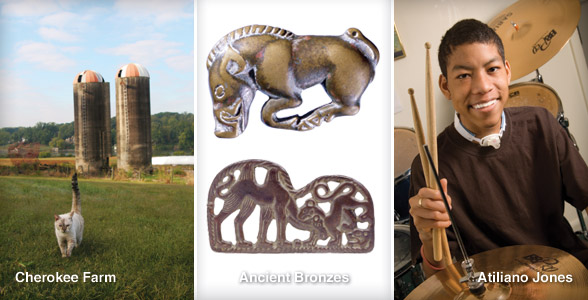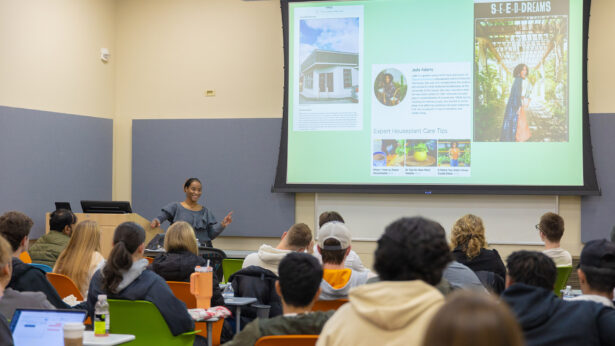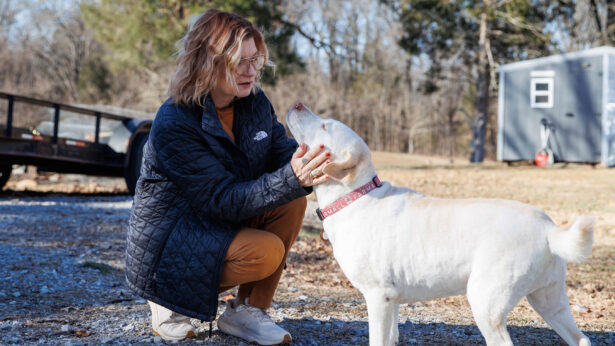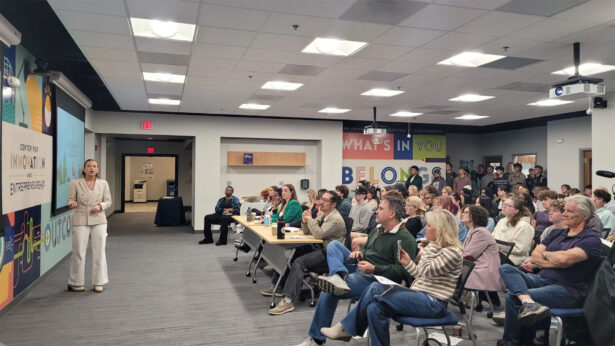Museum Features Ancient Bronzes
Objects from long ago and far away promise a tantalizing museum experience this summer at UT Knoxville. The Frank H. McClung Museum is offering “Ancient Bronzes of the Asian Grasslands,” an exhibit from the Arthur M. Sackler Foundation, through August 3.
The exhibit presents 84 works illustrating the personal decorations and equipment of the horse-riding steppe dwellers of the late second and first millennia b.c.e. Ornate and technically sophisticated bronze belt buckles, plaques, and weapons recall this nomad culture that flourished across the Asian grasslands from Central Asia to Mongolia and northern China.
“Ancient Bronzes of the Asian Grasslands” reveals how this culture used the animal world as a source of symbols indicating tribe, rank, and connections to the spirit world. Elegantly antlered stags, wild boars, and birds of prey are only a few of the creatures found in their art. The exhibit also illustrates the important role these nomads had in carrying artistic influence from China westward along the Silk Route.
Museum hours are 9 a.m. to 5 p.m. Monday through Saturday and 1 to 5 p.m. Sunday. Admission is free. Directions to the museum and parking information are available at http://mcclungmuseum.utk.edu/.
Up through the Ranks
UT Knoxville graduate programs in education, law, speech pathology, and social work gained ground in U.S. News & World Report’s 2009 rankings. Top-flight programs in the College of Business Administration and the College of Arts and Sciences’ School of Art held their prestigious top 5 and top 10 slots, respectively, among all universities in the nation.
The School of Art’s printmaking graduate program is fourth in the nation, with the school’s master of fine arts program ranked 50th overall and 22nd among public universities.
For the third year, the UT Knoxville College of Business Administration’s supply chain and logistics graduate program is ranked 10th in the nation. The program is sixth among public institutions.
The College of Engineering’s specialty in nuclear engineering ranked 11th nationally and 10th among public institutions—one slot higher than last year. The college’s computer engineering specialty ranked 57th nationally, up 11 places from last year, and its overall graduate program ranked 69th nationally and 39th among public institutions.
“With graduate programs becoming ever more vital to our nation, these rankings are a testament to the talent and drive of our faculty and the depth of our academic programs,” Interim Chancellor Jan Simek said. “As we work to raise our profile among national universities, our academic strengths benefit our students and the entire state.”
The College of Education, Health, and Human Sciences’ education graduate program ranked 35th overall, up from 41st place, and 25th among all public institutions.
The College of Law climbed to 52nd overall and 26th place among all public universities. This is among 184 accredited law schools, including 80 national public institutions. The college realized a one-slot gain overall and jumped eight places since 2007. The college’s specialty in clinical training rose to 16th place nationally and eighth place among public institutions, a one-slot jump from last year’s ranking.
The College of Arts and Sciences’ speech pathology graduate program ranked 30th nationally and 25th among public institutions, gaining ground since its 2006 rankings. The college’s graduate program in audiology ranked 24th nationally.
Also raising its profile is the College of Social Work’s graduate program, which ranked 26th overall and 15th among public universities. The program climbed two slots among all schools since it was last ranked in 2005.
UT Knoxville has 6,000 graduate students.
Farm of the Future
Room to grow. A place for scientific research to thrive. Few universities have the opportunity to give birth to an entire new “campus” dedicated to the promise of the future. But that’s what UT has in Cherokee Farm in Knoxville.
A former dairy farm for the UT Institute of Agriculture, the research campus is located on Alcoa Highway south of Fort Loudon Lake, near the main campus. The university has $32 million in state funds to begin site preparation.
In keeping with the land’s history as a farm, eco-friendly development is planned for the 200-acre site. Plans for the research buildings will stress conservation of energy and water resources. The first facility expected to go up is the UT–Oak Ridge National Laboratory Joint Institute for Materials Science.
As a shared resource of UT, Oak Ridge National Laboratory, and other public and private partners, Cherokee Farm will be home to research that is expected to boost economic development in Tennessee and quality of life for Tennesseans. The university is recruiting businesses to locate on the site, building on the abundant scientific and technological resources already in the area. The university is in the process of relocating the dairy to nearby Blount County.
Complete information about Cherokee Farm is available at www.tennessee.edu/system/cherokee.
Atiliano Update
Although his treatment has been a roller-coaster ride of highs and lows, Atiliano Jones Jr. appears to be on the road to recovery. The 15-year-old boy from Belize was featured in the winter 2008 issue of Tennessee Alumnus. He came to Knoxville for treatment of a tumor the size of a cantaloupe growing inside his head. A group of faculty members and students from UT Knoxville’s College of Nursing met him while they were on a service trip to Belize last year.UT clinical instructor Mary Sowell spearheaded efforts to bring Atiliano to the U.S. The College of Nursing paid for the trip for Atiliano and his mother, Nadean, and UT Medical Center pledged to provide the needed medical care without charge.
Atiliano suffers from juvenile nasopharyngeal angiofibroma (JNA), a benign yet aggressive vascular head and neck tumor. JNA is a rare condition that almost always affects adolescent boys. He arrived in Knoxville about a year ago, but arranging his treatment was more difficult than expected.
In mid-August, with the help of Dr. Judah Folkman—whom Business Week once called “one of the world’s most renowned cancer researchers”—local doctors started Atiliano on an experimental treatment using low-dose interferon to shrink the tumor by reducing the blood supply to it.
Sowell gave Atiliano daily injections, which cost about $40 a day. The treatment was expected to continue for 6 to 12 months.
But in November 2007 Roche Laboratories announced it would quit making Roferon-A, the drug Atiliano had been using. It was being replaced by a similar drug administered just once a week instead of daily but much more expensive than Roferon-A.
Sowell enlisted the help of a pharmacist at Fort Sanders Medical Center to stockpile as much Roferon-A as possible.
“We found enough for two-and-a-half months,” Sowell said.
When the supply ran out, Atiliano’s doctors decided to switch him to Intron, another interferon drug that’s administered daily. As yet, they’re unsure what, if any, effect the change will have.
Then early this year, Folkman died of a massive heart attack at the Denver airport.
“It took away our stability,” Sowell said. “It makes us feel a little bit less sure.” But some of Folkman’s colleagues have stepped in to help oversee Atiliano’s treatment plan, she said.
And if there weren’t already enough things to fret about, the visas for Atiliano and his mother expired. With the boy still in treatment, Sowell is trying to enlist the help of legislators to get extensions.
Sowell has been able to look in Atiliano’s mouth and see that the tumor has been shrinking, but she has noticed something peculiar lately.
“I can’t tell if the tumor is growing back or reformatting itself,” she said. “It may just be his tonsils or his uvula, which we couldn’t see well before.”
Atiliano is scheduled for an MRI that should yield some answers. Despite everything, he’s breathing better, talking better, and eating better. His weight has gone from 94 pounds to 111 pounds. And he now has a teenager’s zest for life.
“He is full of himself,” Sowell said.
Accreditation Benefits UTC Students
UT Chattanooga’s College of Health, Education, and Professional Studies is proud, and for good reason: All its programs eligible for national accreditation have achieved that status.
The School Psychology Program in the college’s Graduate Studies Division is the latest unit to be accredited. Approval came from the National Association of School Psychologists.
“The advantage of having all programs nationally accredited goes beyond the pride and prestige of accomplishing this goal,” says Dr. John Freeman. “It also says to the community and the state that UTC has a wide array of programs in the College of Health, Education, and Professional Studies, and they are all of the highest quality.” Freeman is associate professor and department head in the Graduate Studies Division.
He says the accreditation of the School Psychology Program is a good thing for students.
“It provides our students with the ability to gain national certification, which will make them marketable outside the state of Tennessee. By advertising this fact, UTC will now be able to expand its recruitment to the Southeast region, making our program more attractive and viable to a wider range of students.”
The School Psychology Program has to stay on its toes—accreditation will be reviewed in 2009, Freeman says. “We are required to continue to monitor and improve our program to maintain this accreditation.” That, he says, “keeps us fresh, up-to-date, and relevant.”
Freeman credits Mary Tanner, dean of the college, as “the driving force behind the college’s effort to seek national accreditation for all programs.”
“We always remind each other that we seek this type of review and attainment because our students deserve it,” Tanner says.
Vols Step Up for Chadwick
Never underestimate the power of the Vol Nation.
As soon as the story of mid-1960s football hero Walter Chadwick, severely brain injured and disabled in a 1971 auto accident, appeared in the spring 2008 Tennessee Alumnus, e-mails and offers of help came pouring in.
From Memphis: “I guess I looked pretty silly sitting in my office with tears welling up in my eyes, but that’s what the story did to me. Chadwick and Kiner [Steve, who got the ball rolling to turn Chadwick’s life around] were only about four years older than me, but they were still my heroes.”
From the daughter of Ruth Anne Bacon, former housemother at Gibbs Hall athletic dorm: “When you see Walter again, please tell him that Mrs. Bacon, his UT housemother at Gibbs Hall, sends her very best to him. She is still a faithful Vol fan and keeps up with all of the UT sports (men’s and women’s teams). She most especially keeps up with ‘her boys’ who lived in Gibbs Hall when she was there.”
Many have offered financial assistance; many more want to keep in touch to see how Chadwick is doing.
The answer is, “Very well, thank you.”
Thanks to the efforts of miracle-working carpenter Joe Brown and contractor Trish Sheffield, his derelict townhouse in Decatur, Georgia, has been stripped down to the studs and rebuilt. A stair chair helps him reach his second-floor bedroom.
“It is hard to even remember the sad state the house was in when we first met Walter over two years ago,” writes UT alumna Ellen Morrison, a charter member of Friends of Walter.
Pride in his new furniture, carpet, appliances, and fixtures has almost cured Chadwick of treasure-hunting for neighborhood castoffs. In places of honor in his redecorated living room are a framed charcoal drawing from 1966 by UT Knoxville art student Chris Findley and a collage of clippings his late father had kept, detailing his stellar gridiron career at Decatur High.
Friends take him to lunch weekly, and he is still encouraging other brain-damaged patients at his job with Emory Healthcare. He is facing shoulder surgery himself, but that hasn’t slowed his pace. The loving kindness of Ellen and Philip Morrison, Kiner, Marilyn Elrod, and neighbors Stacy and Kathryn Burnette and the many UT alumni running interference for him just goes to show that underneath all those orange sweaters beat hearts of gold.
(You can still join the Friends of Walter team. E-mail Ellen Morrison at pjmorrison@aol.com.)



